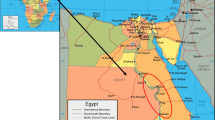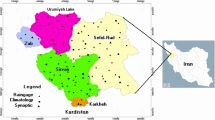Abstract
Climate change is a significant global issue that will affect regional agriculture and water management of irrigation supplies. In this study, we project climate change impacts on water and irrigation requirements for major crops—wheat, cotton, and apricots—in Balkh province, Afghanistan. The methodology utilizes satellite imagery to overcome limitations in ground measurements necessary to understand current crop conditions and cultivation schedules for the study site. The climate model-averaged results project an increasing trend in both crop water and irrigation requirements for the study area, with larger trends for the climate model and scenario combinations that project the largest temperature increases. Future trends in the year-to-year variability of field water requirements do not contain a clear trend for most crops. The magnitude of projected changes vary significantly between individual climate models, demonstrating the importance of applying multiple climate models to project future conditions in agricultural water management. The results demonstrate the efficacy of using globally available data, including satellite imagery and global climate model information, to overcome lack of in situ observations. The findings also highlight challenges to current agricultural paradigms in areas such as Afghanistan that are arid to semi-arid and do not have adequate irrigation infrastructure.










Similar content being viewed by others
References
Aich V, Khoshbeen AJ (2016) Afghanistan: climate change science perspectives. National Environmental Protection Agency and UN Environment, Kabul
Allen RG, Pereira LS, Raes D, Smith M (1998) Crop Evapotranspiration: Guidelines for computing crop water requirements. FAO Irrigation and Drainage Paper 56. FAO, Rome
Arvor D, Jonathan M, Meirelles MSP, Dubreuil V, Durieux L (2011) Classification of MODIS EVI time series for crop mapping in the state of Mato Grosso, Brazil. Int J Remote Sens 32:7847–7871
Ashofteh P-S, Bozorg-Haddad O, Akbari-Alashti H, Mariño MA (2015a) Determination of irrigation allocation policy under climate change by genetic programming. J Irrig Drain Eng 141(4):04014059. https://doi.org/10.1061/(ASCE)IR.1943-4774.0000807
Ashofteh P-S, Bozorg-Haddad O, Mariño MA (2015b) Risk analysis of water demand for agricultural crops under climate change. J Hydrol Eng 20(4):04014060. https://doi.org/10.1061/(ASCE)HE.1943-5584.0001053
Ashofteh P-S, Bozorg-Haddad O, Mariño MA (2016) Performance evaluation of a developed hybrid AOGCM model under climate change. J Irrig Drain Eng 142(12):04016068. https://doi.org/10.1061/(ASCE)IR.1943-4774.0001107
Ashofteh P-S, Bozorg-Haddad O, Loáiciga HA (2017) Development of adaptive strategies for irrigation water demand management under climate change. J Irrig Drain Eng 143(2):04016077. https://doi.org/10.1061/(ASCE)IR.1943-4774.0001123
Belgiu M, Csillik O (2018) Sentinel-2 cropland mapping using pixel-based and object-based timeweighted dynamic time warping analysis. Remote Sens Environ 204:509–523
Bigelow DP, Zhang H (2018) Supplemental irrigation water rights and climate change adaptation. Ecol Econ 154:156–167
Black M (2016) The atlas of water, 3rd edn. University of California Press, Oakland
Brouwer C, Heibloem M (1986) Irrigation water needs. Irrigation water management training manual no. 3. FAO, Rome. http://www.fao.org/docrep/S2022E/S2022E00.htm. Accessed 16 June 2018
Chowdhury S, Al-Zahrani M, Abbas A (2016) Implications of climate change on crop water requirements in arid region: an example of Al-Jouf, Saudi Arabia. J King Saud Univ Eng Sci 28:21–31
Cid P, Taghvaeian S, Hansen NC (2018) Evaluation of the FAO-56 methodology for estimating maize water requirements under deficit and full irrigation regimes in semiarid northeastern Colorado. Irrig Drain 67:605–614
Dee DP, Uppala SM, Simmons AJ, Berrisford P, Poli P, Kobayashi S, Andrae U, Balmaseda MA, Balsamo G, Bauer P, Bechtold P, Beljaars ACM, van de Berg L, Bidlot J, Bormann N, Delsol C, Dragani R, Fuentes M, Geer AJ, Haimberger L, Healy SB, Hersbach H, Hólm EV, Isaksen L, Kållberg P, Köhler M, Matricardi M, McNally AP, Monge-Sanz BM, Morcrette J-J, Park B-K, Peubey C, de Rosnay P, Tavolato C, Thépaut J-N, Vitart F (2011) The ERA-Interim reanalysis: configuration and performance of the data assimilation system. Q J R Meteorol Soc 137:553–597
Doorenbos J, Pruitt WO, Aboukhaled A, Damagnez J, Dastane NG, van den Berg C, Rijtema PE, Ashford OM, Frère M, FAO Field Staff (1992) Crop water requirements. FAO Irrigation and Drainage Paper 24. FAO, Rome
FAO (2016) The Islamic Republic of AFGHANISTAN land cover ATLAS. http://www.fao.org/3/a-i5043e.pdf. Accessed 10 July 2018
Fischer G, Tubiello FN, van Velthuizen H, Wiberg DA (2007) Climate change impacts on irrigation water requirements: effects of mitigation, 1990–2080. Technol Forecast Soc Change 74(7):1083–1107
Gohar AAA (2013) An economic approach to sustainable irrigation management: methods and policy applications. Ph.D. dissertation, New Mexico State University
Hargreaves GH, Samani ZA (1985) Reference crop evapotranspiration from temperature. Appl Eng Agric 1:96–99
Jensen ME, Allen RG, Howell TA, Martin DL, Snyder R, Walter IA (2016) Evaporation, evapotranspiration, and irrigation water requirements, 2nd edn. ASCE Manuals and Reports on Engineering Practice, No. 70. American Society of Civil Engineers, Reston
Lee S-H, Yoo S-H, Choi J-Y, Bae S (2017) Assessment of the impact of climate change on drought characteristics in the Hwanghae Plain, North Korea using time series SPI and SPEI: 1981–2100. Water 9:579. https://doi.org/10.3390/w9080579
Li J-LF, Waliser DE, Stephens G, Lee S, L’Ecuyer T, Kato S, Loeb N, Ma H-Y (2013) Characterizing and understanding radiation budget biases in CMIP3/CMIP5 GCMs, contemporary GCM, and reanalysis. J Geophys Res Atmos 118:8166–8184
Mani M, Bandyopadhyay S, Chonabayashi S, Mosier T (2018) South Asia’s hotspots: the impact of temperature and precipitation changes on living standards. South Asia Development Matters. World Bank, Washington, DC. https://doi.org/10.1596/978-1-4648-1155-5
Menzel L, Bürger G (2002) Climate change scenarios and runoff response in the Mulde catchment (Southern Elbe, Germany). J Hydrol 267(1–2):53–64
Mosier TM, Hill DF, Sharp KV (2014) 30-Arcsecond monthly climate surfaces with global land coverage. Int J Climatol 34:2175–2188
Mosier TM, Hill DF, Sharp KV (2017) Update to the Global Climate Data package: analysis of empirical bias correction methods in the context of producing very high resolution climate projections. Int J Climatol 38:825–840
Moursi H, Kim D, Kaluarachchi JJ (2017) A probabilistic assessment of agricultural water scarcity in a semi-arid and snowmelt-dominated river basin under climate change. Agric Water Manag 193:142–152
Mulianga B, Bégué A, Clouvel P, Todoroff P (2015) Mapping cropping practices of a sugarcane-based cropping system in Kenya using remote sensing. Remote Sens 7:14428–14444
Mullan B, Porteous A, Wratte D, Hollis M (2005) Changes in drought risk with climate change. NIWA Client Report WLG2005-23. National Institute of Water & Atmospheric Research Ltd., Auckland
Murthy CS, Raju PV, Jonna S, Hakeem KA, Thiruvengadachari S (1998) Satellite derived crop calendar for canal operation schedule in Bhadra project command area, India. Int J Remote Sens 19:2865–2876
NAIS (2008) Accelerating sustainable agriculture program. Balkh Province Agricultural Profile. National Agriculture Information System (NAIS)/AgNet. http://afghanag.ucdavis.edu/country-info/province/files/profile-Balkh.pdf. Accessed 3 Mar 2018
Pan Z, Huang J, Zhou Q, Wang L, Cheng Y, Zhang H, Blackburn GA, Yan J, Liu J (2015) Mapping crop phenology using NDVI time-series derived from HJ-1A/B data. Int J Appl Earth Obs Geoinf 34:188–197
Reeling CJ, Lee J, Mitchell P, Halimi GH, Carver A (2012) Policy options to enhance agricultural irrigation in Afghanistan: a canal systems approach. Agric Syst 109:90–100
Rockström J, Steffen W, Noone K, Persson Å, Chapin FS III, Lambin EF, Lenton TM, Scheffer M, Folke C, Schellnhuber HJ, Nykvist B, de Wit CA, Hughes T, van der Leeuw S, Rodhe H, Sörlin S, Snyder PK, Costanza R, Svedin U, Falkenmark M, Karlberg L, Corell RW, Fabry VJ, Hansen J, Walker B, Liverman D, Richardson K, Crutzen P, Foley JA (2009) A safe operating space for humanity. Nature 461:472–475
Saboory MS (2015) Selection of suitable water harvesting sites using multi-criteria evaluation (MCE) and GIS in Khulm watershed, Afghanistan. Master’s Thesis, Graduate School of Life and Environmental Science, Shimane University
Saffi MH (2007) Groundwater resources at risk in Afghanistan. Scientific investigation report in Afghanistan. Danish Committee for Aid to Afghan Refugees (DACAAR), Kabul
Salathé EP Jr, Mote PW, Wiley MW (2007) Review of scenario selection and downscaling methods for the assessment of climate change impacts on hydrology in the United States pacific northwest. Int J Climatol 27:1611–1621
Sánchez N, Martínez-Fernández J, González-Piqueras J, González-Dugo MP, Baroncini-Turrichia G, Torres E, Calera A, Pérez-Gutiérrez C (2012) Water balance at plot scale for soil moisture estimation using vegetation parameters. Agric For Meteorol 166–167:1–9
Savva AP, Frenken K (2002) Crop water requirements and irrigation scheduling. FAO Sub-Regional Office for East and Southern Africa, Harare
Senga Y (1985) Water Safety and reservoir operation. J Jpn Soc Irrig Drain Reclam Eng 53:203–210 (in Japanese)
Sivakumar MVK, Das HP, Brunini O (2005) Impacts of present and future climate variability and change on agriculture and forestry in the arid and semi-arid tropics. Clim Change 70:31–72
SOC (2008) Managing an uncertain future—climate change adaptation strategies for California’s water. State of California, Department of Water Resources, Sacramento
Sun SK, Li C, Wu PT, Zhao XN, Wang YB (2018) Evaluation of agricultural water demand under future climate change scenarios in the Loess Plateau of Northern Shaanxi, China. Ecol Ind 84:811–819
Surendran U, Sushanth CM, Mammen G, Joseph EJ (2015) Modelling the crop water requirement using FAO-CROPWAT and assessment of water resources for sustainable water resource management: a case study in Palakkad district of humid tropical Kerala, India. Aquat Proc 4:1211–1219
Tasumi M, Allen RG (2007) Satellite-based ET mapping to assess variation in ET with timing of crop development. Agric Water Manag 88:54–62
Tasumi M, Allen RG, Trezza R, Wright JL (2005) Satellite-based energy balance to assess within-population variance of crop coefficient curves. J Irrig Drain Eng 131:94–109
Tasumi M, Hirakawa K, Hasegawa N, Nishiwaki A, Kimura R (2014) Application of MODIS land products to assessment of land degradation of Alpine rangeland in Northern India with limited ground-based information. Remote Sens 6:9260–9276
Torell GL, Ward FA (2010) Improved water institutions for food security and rural livelihoods in Afghanistan’s Balkh river basin. Int J Water Resour Dev 26(4):613–637
USGS (2018) Landsat 8 (L8) Data Users Handbook Version 3.0. Landsat Project Science Office, Department of the Interior, U.S Geological Survey, Sioux Falls
van Vuuren DP, Edmonds J, Kainuma M, Riahi K, Thomson A, Hibbard K, Hurtt GC, Kram T, Krey V, Lamarque J-F, Masui T, Meinshausen M, Nakicenovic N, Smith SJ, Rose SK (2011) The representative concentration pathways: an overview. Clim Change 109:5–31
Verbeiren S, Eerens H, Piccard I, Bauwens I, Van Orshoven J (2008) Sub-pixel classification of SPOT-VEGETATION time series for the assessment of regional crop areas in Belgium. Int J Appl Earth Obs Geoinf 10:486–497
Walters SA, Groninger JW, Myers O Jr (2012) Rebuilding Afghanistan’s agricultural economy: vegetable production in Balkh province. Outlook Agric 41(1):7–13
Wang X-J, Zhang J-Y, Shahid S, Guan E-H, Wu Y-X, Gao J, He R-M (2016) Adaptation to climate change impacts on water demand. Mitig Adapt Strateg Glob Change 21:81–99. https://doi.org/10.1007/s11027-014-9571-6
Wardlow BD, Egbert SL, Kastens JH (2007) Analysis of time-series MODIS 250 m vegetation index data for crop classification in the U.S. Central Great Plains. Remote Sens Environ 108:290–310
Zhou T, Wu P, Sun S, Li X, Wang Y, Luan X (2017) Impact of future climate change on regional crop water requirement—a case study of Hetao Irrigation District, China. Water 9:429. https://doi.org/10.3390/w9060429
Acknowledgements
This study is conducted as a part of a World Bank Project, “Pilot Climate Change Impact Analysis on Hydrology and Agriculture in Afghanistan (P160070)” and JSPS KAKENHI Grant Number JP18K05886. Authors acknowledge Ms. Akiko Nakagawa, Mr. Shoaib Saboory, and other World Bank members for collaborative support.
Author information
Authors and Affiliations
Corresponding author
Ethics declarations
Conflict of interest
The authors declare that they have no conflict of interest.
Additional information
Communicated by P. Waller.
Publisher's Note
Springer Nature remains neutral with regard to jurisdictional claims in published maps and institutional affiliations.
Rights and permissions
About this article
Cite this article
Jami, A., Tasumi, M., Mosier, T.M. et al. Evaluation of the effects of climate change on field-water demands using limited ground information: a case study in Balkh province, Afghanistan. Irrig Sci 37, 583–595 (2019). https://doi.org/10.1007/s00271-019-00638-2
Received:
Accepted:
Published:
Issue Date:
DOI: https://doi.org/10.1007/s00271-019-00638-2




